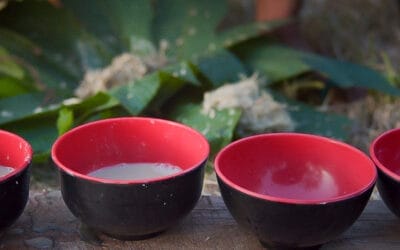IT’S KAVA TIME
Time to prepare a batch of kava, sit down and relax for a while. As you enjoy downing a shell of kava and mellowing out for the evening, alone or with friends, share and enjoy these ten fun facts about kava. Kava time it is! Read on.

1. Kava’s origins are a mystery
No one knows for sure the origins of the kava plant – it’s a mystery.
Today, the general consensus is that kava originated in Vanuatu. Some even say, more specifically, Northern Vanuatu, perhaps even the island of Maewo.
While this remains scientifically unproven the fact that Vanuatu has the greatest number of kava varieties, far more than any other island and some of the strongest kava varieties, its certainly evidence to support this theory

2. KAVA IS INFERTILE
A kava plant is sterile. It can’t reproduce naturally.
Female flowers are very rare and do not produce fruit or seeds, even when a plant is hand-pollinated.
Kava farmers use propagation to plant and grow new kava plants. Each kava plant is specifically cultivated from a node on a 3”-4” segment of a stalk, that planted in the earth will sprout a new kava plant.

3. KAVA PLANTS TAKE FOUR YEARS TO MATURE
Kava farming requires patience.
A kava plant takes four years to mature and be ready for harvest. Only the root of a mature plant will provide the relaxation benefits kava is known for. After harvesting, the kava roots are washed and dried for export. Kava time is about slowing things down and patience, but all good things are worth waiting for.
Find out more about kava plant cultivation.

4. KAVA CULTURE IS DEEP-ROOTED
Kava drinking has been a tradition throughout the Pacific Islands for centuries. For thousands of years, these islands have held the kava plant in high regard.
A kava drinking ceremony is always part of prestigious occasions such as the installation of a new village Chief, the signing of agreements between communities, or the welcoming of an important visitor e.g. a member of the British Royal family.

5. KAVA HAS MULTIPLE NAMES AND VARIETIES
Throughout the Pacific Islands, kava is known by many different names. In Hawaii, kava is called Awa. In Fiji, where kava is the official national drink, it is called both Yaqona and Malogu. Yaqona, means bitter and refers to the bitter, earthy taste of kava. Malogu means subdue, and refers to the calming effects of a drink of kava. In Samoa, kava is called Ava. Amazingly, there are over 103 kava plant varieties. Find out more about kavas varieties and origins.

6. KAVA TIME: HEADY, HEAVY AND BALANCED KAVAS
Kavas are described as being heady, heavy or balanced based on the effects of the active ingredients in a specific variety. A heady kava is one that will be uplifting and boost your mood, perhaps even making you feel euphoric. Heavy kavas are the more sedating varieties that make your muscles relax and your body feels like it is heavy. Heady kavas are great sleep aids. Balanced kavas have both a mix of heady and heavy effects.
7. KAVALACTONES ARE THE ACTIVE INGREDIENTS IN KAVA
There is a growing body of scientific research into kava and its calming effects that are produced by the active ingredients in kava.
These active ingredients are called kavalactones. There are 18 kavalactones with just six being responsible for 90% of the relaxation effects of most kava varieties. Kava’s active ingredients have been shown to interact with the amygdala in the limbic system of the brain that is responsible for regulating feelings of fear and anxiety.

8. FLORIDA IS THE KAVA CAPITAL OF THE U.S.
There are now over 180 kava bars throughout the United States.
The largest number by far are found in Florida which is home to 79 kava bars.
And St Pete’s Florida is said to be the kava capital of the U.S.A. It’s kava time all the time there!
Find your nearest kava bar.

9. JIMMY BUFFET IS A FAN OF KAVA
In his book ‘A Salty Piece of Land,’ author and musician Jimmy Buffet writes:
“I felt at though I had spent a week at a five-star spa. I can’t tell you why, but I felt no residual effects from the kava, no headache, no flash back. The numbness had left my body, and my eyes were clear. I felt as if my body was fully recharged for the first time in years.”
We hope you when you enjoy kava time you have the same great experience.
10. KAVA TIME: KAVA IS A PEACE OFFERING AND IMPORTANT GIFT
Kava has always been a peace offering. Many years ago, when island inhabitants set out in canoes to explore and find other islands, they took kava with them. They knew that offering a drink of kava would result in more peaceful dialogue and negotiations with their newfound neighbors. Even today, travelers and sailors visiting the island nations of the Pacific are encouraged to bring with them kava for the village Chief when they seek permission to disembark and explore. In Fiji this is known as a Sevusevu ceremony. Watch this video of an young English couple who are sailing around the world do just that on Vanua Balavu in Eastern Fiji.
Why not give a gift of kava today?
We hope you enjoyed these ten fun facts for kava time. Any you would add? Let us know in the comments below.
If you are new to kava, here’s where you can learn exactly what kava is and why it is so popular.
Wishing you all a happy kava time.
Bula.


